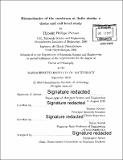| dc.contributor.advisor | Simona Socrate and Subra Suresh. | en_US |
| dc.contributor.author | Prévost, Thibault Philippe | en_US |
| dc.contributor.other | Massachusetts Institute of Technology. Department of Materials Science and Engineering. | en_US |
| dc.date.accessioned | 2017-12-05T19:15:42Z | |
| dc.date.available | 2017-12-05T19:15:42Z | |
| dc.date.copyright | 2010 | en_US |
| dc.date.issued | 2010 | en_US |
| dc.identifier.uri | http://hdl.handle.net/1721.1/112502 | |
| dc.description | Thesis: Ph. D., Massachusetts Institute of Technology, Department of Materials Science and Engineering, 2010. | en_US |
| dc.description | Cataloged from PDF version of thesis. | en_US |
| dc.description | Includes bibliographical references (pages 109-124). | en_US |
| dc.description.abstract | The present study addresses the large strain nonlinear mechanical response of the cerebral cortex at the macroscopic tissue level and at the microscopic cell level. Unconfined uniaxial compression tests were conducted in vitro on cortical samples of porcine brains. The tests consisted of load-unload and relaxation segments to 50% nominal deformation at 0.01 to 10 s-1 strain rates. The tissue exhibited moderate volumetric compressibility, marked hysteretic features, and substantial nonlinearities. Indentation tests - with displacement histories mirroring those imposed in compression - were performed on the cortex of porcine brains in vivo, in situ and in vitro, in order to assess and contrast the mechanical properties of the live and dead tissue. The tissue response shared similar qualitative nonlinear viscoelastic features under all testing conditions, although, quantitatively, the response was found to be significantly stiffer in situ than in vivo. Test protocols were also developed at the neuronal cell level using atomic force microscopy. The response of individual somata to cyclic load-unload and relaxation test sequences was found to be nonlinear with time dependencies and hysteretic patterns similar to those measured at the tissue level. A large strain kinematics nonlinear continuum model was proposed to capture the features of the tissue and cell responses. The model was numerically implemented into a three-dimensional finite-element framework. The continuum formulation was found to successfully account for the main experimental observations gathered in vitro at the tissue and cell levels. The present study provides novel insights into the tissue rheology in vivo, in situ and in vitro, at large strains, in the quasi-static and dynamic strain rate regime and reports the first body of observations on the large strain nonlinear viscoelastic properties of brain tissue in vivo. These observations could be directly compared to those pertaining to the tissue response in situ and in vitro, thereby providing a unique quantitative basis for further refinements of existing biomechanical models relying only on in vitro/situ measurements. The consistent set of mechanical data collected, and the constitutive framework proposed at the tissue and cell levels might support the development of multiscale numerical models to study traumatic brain injury. | en_US |
| dc.description.statementofresponsibility | by Thibault Philippe Prévost. | en_US |
| dc.format.extent | 124 pages | en_US |
| dc.language.iso | eng | en_US |
| dc.publisher | Massachusetts Institute of Technology | en_US |
| dc.rights | MIT theses are protected by copyright. They may be viewed, downloaded, or printed from this source but further reproduction or distribution in any format is prohibited without written permission. | en_US |
| dc.rights.uri | http://dspace.mit.edu/handle/1721.1/7582 | en_US |
| dc.subject | Materials Science and Engineering. | en_US |
| dc.title | Biomechanics of the cerebrum at finite strain : a tissue and cell level study/ | en_US |
| dc.type | Thesis | en_US |
| dc.description.degree | Ph. D. | en_US |
| dc.contributor.department | Massachusetts Institute of Technology. Department of Materials Science and Engineering | |
| dc.identifier.oclc | 1011525900 | en_US |
